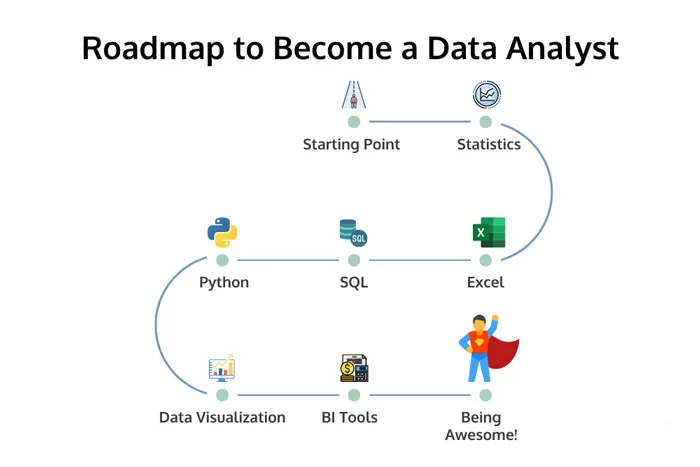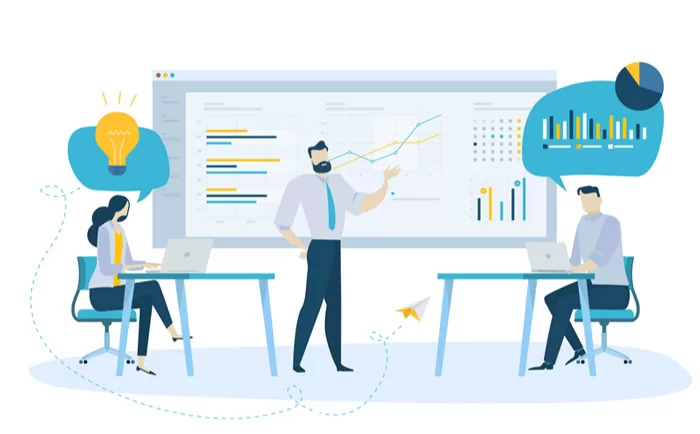In the rapidly evolving world of data analysis, having a clear roadmap is crucial to navigate the vast sea of information and technologies. This article aims to provide a comprehensive guide to the data analysis roadmap for 2023. We will explore the different types of data analysis, discuss the importance of data analysis courses, and delve into the broader Data Science roadmap. By understanding these key elements, professionals and aspiring data analysts can chart their course to success in the dynamic field of data analysis.
clslearn offers you the best courses in the course of Data Analyst
Data Analysis Roadmap:

The data analysis roadmap serves as a guide for individuals seeking to develop their skills and expertise in data analysis. It outlines the sequential steps and areas of focus necessary to become proficient in extracting insights from data. A typical data analysis roadmap may include the following stages:
- Foundation: Establishing a strong foundation in mathematics, statistics, and programming forms the bedrock of data analysis. Understanding concepts such as probability, hypothesis testing, and data manipulation provides a solid base for more advanced analysis techniques.
- Tools and Technologies: Familiarize yourself with popular data analysis tools and technologies such as Python, R, SQL, and Excel. These tools enable data manipulation, visualization, and statistical analysis, allowing you to extract meaningful insights from datasets.
- Exploratory Data Analysis (EDA): EDA involves understanding the structure and characteristics of the data through visualizations, statistical summaries, and data profiling. This step helps identify patterns, outliers, and relationships within the dataset before diving into more complex analysis techniques.
- Statistical Analysis: Develop a solid understanding of statistical techniques such as regression analysis, hypothesis testing, and analysis of variance (ANOVA). These techniques provide the foundation for drawing meaningful conclusions and making data-driven decisions.
- Machine Learning: Explore the field of machine learning, which involves using algorithms to build predictive models and uncover patterns in data. Familiarize yourself with popular machine learning algorithms, such as linear regression, decision trees, and neural networks, and learn how to evaluate and fine-tune these models.
- Data Visualization: Master the art of data visualization to effectively communicate insights and findings. Learn how to create visually appealing and informative charts, graphs, and dashboards using tools like Tableau, Power BI, or Python libraries like Matplotlib and Seaborn.
- Communication and Storytelling: Develop strong communication skills to effectively convey complex findings to non-technical stakeholders. Learn how to tell compelling data stories and present insights in a clear and concise manner.
Get to know about: COMPREHENSIVE OVERVIEW OF THE POWER BI SYLLABUS AND CURRICULUM
Types of Data Analysis:
Data analysis encompasses various approaches, each serving a specific purpose. Some common types of data analysis include:
- Descriptive Analysis: Describes and summarizes data using measures such as mean, median, and standard deviation. It helps to understand the characteristics and trends present in the dataset.
- Diagnostic Analysis: Seeks to identify the causes and reasons behind certain phenomena or outcomes. It involves investigating relationships and correlations between variables to uncover insights.
- Predictive Analysis: Uses historical data to make informed predictions about future outcomes. Techniques such as regression analysis and time series forecasting are applied to make reliable forecasts.
- Prescriptive Analysis: Provides recommendations and suggests optimal courses of action. It combines predictive models with optimization techniques to guide decision-making processes.
Data Analysis Courses:
Enrolling in data analysis courses is a valuable investment for both beginners and experienced professionals. These courses offer structured learning paths, hands-on projects, and access to expert instructors. They cover essential topics such as data manipulation, statistical analysis, data visualization, and machine learning. Online platforms like Coursera, Udemy, and DataCamp offer a wide range of data analysis courses suitable for various skill levels and interests.
Data Science Roadmap:

The Data Science roadmap encompasses a broader set of skills and knowledge beyond data analysis. It includes additional areas such as data engineering, big data processing, and advanced machine learning techniques. Data Science roadmaps often encompass topics like data acquisition, data cleaning, feature engineering, deep learning, natural language processing (NLP), and cloud computing. Understanding the Data Science roadmap can help data analysts expand their skill set and progress towards more complex and challenging roles.
Get to know about POWER BI VS EXCEL: DECIDING BETWEEN THE TWO
Some additional points to help you figure out how to start your path in the world of data analysis:
- Advanced Statistical Analysis: Once you have a solid foundation in statistical analysis, you can explore more advanced techniques. This may include multivariate analysis, time series analysis, cluster analysis, factor analysis, and more. Advanced statistical methods allow for more sophisticated insights and modeling capabilities.
- Data Wrangling and Cleaning: Data analysis often involves working with real-world datasets that may be messy, incomplete, or contain errors. Learning techniques for data wrangling and cleaning is essential to ensure data quality and accuracy. This involves handling missing data, dealing with outliers, standardizing data formats, and transforming variables as needed.
- Data Mining and Pattern Recognition: Data mining techniques aim to discover patterns, relationships, and insights from large and complex datasets. This involves applying algorithms and machine learning techniques to identify hidden patterns or associations that may not be immediately apparent. Data mining can be particularly useful for tasks such as market segmentation, customer profiling, fraud detection, and anomaly detection.
- Text Mining and Natural Language Processing (NLP): With the proliferation of text data, text mining and NLP have become important areas of data analysis. These techniques involve extracting useful information from unstructured text data, such as customer reviews, social media posts, or news articles. NLP techniques enable tasks like sentiment analysis, topic modeling, text classification, and named entity recognition.
As we venture into 2023, having a well-defined data analysis roadmap is essential for professionals looking to thrive in the field. By following the sequential steps outlined in the roadmap, individuals can build a strong foundation, gain expertise in various data analysis techniques, and master the art of data visualization and storytelling. Additionally, exploring the broader Data Science roadmap opens up new horizons and opportunities for growth. By embracing continuous learning, staying up to date with emerging technologies, and honing their skills, data analysts can confidently navigate the ever-evolving landscape of data analysis and make meaningful contributions in their organizations.
























